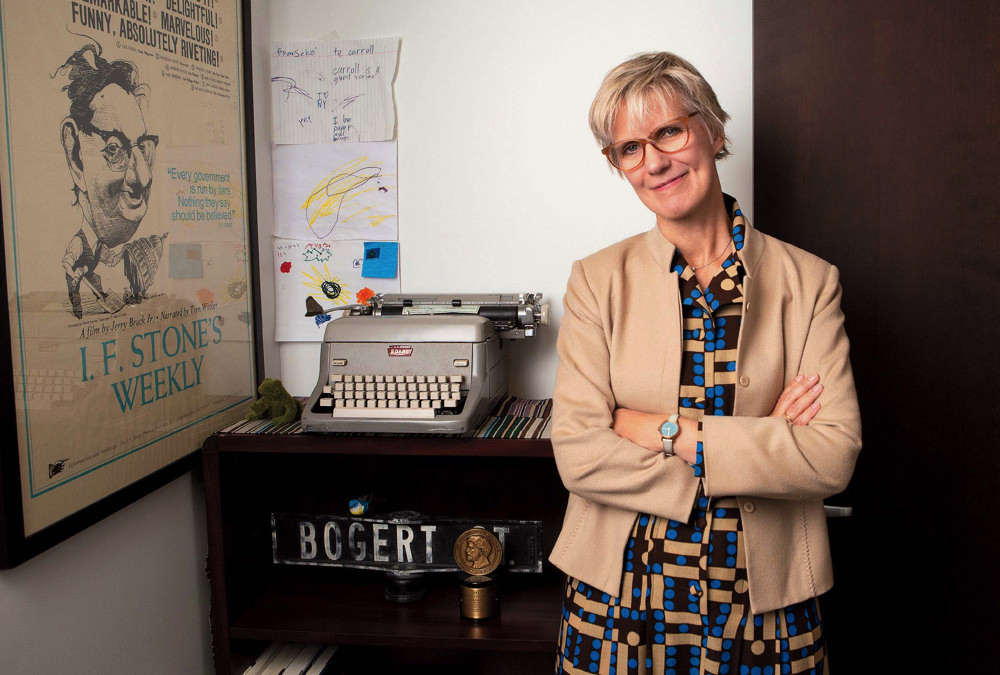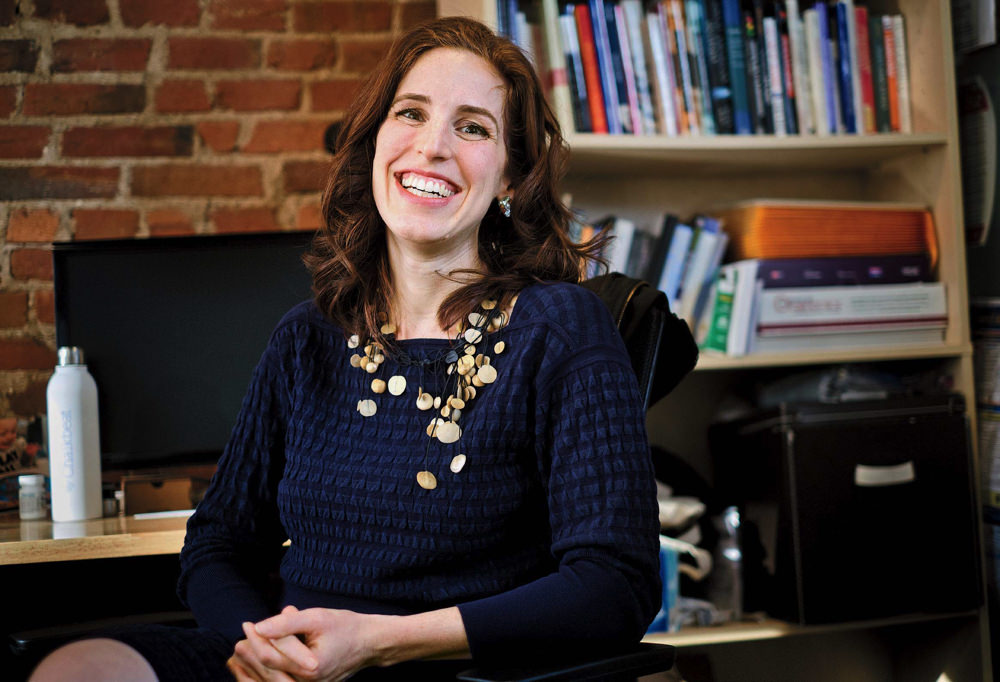Walter Cronkite stepped to the podium before a respectful audience at Harvard one November evening in 1990. An avuncular legend of broadcast journalism, celebrated as “the most trusted man in America,” he was an obvious choice to initiate an annual lecture series at the Kennedy School’s Shorenstein Center on Media, Politics and Policy. Cronkite shared insider tales from the 1950s and ’60s as he described the unfortunate effects of television on American politics: shallow debates, shrinking soundbites, image over substance.
The ninth of 11 questions he fielded pointed him toward the future. “There is the imminent emergence of a digital, global information environment with the instantaneous transmission of information…in many forms almost anywhere,” his questioner said. Combined with the proliferation of cable channels and worldwide satellite broadcasting, where would this lead? In response, Cronkite foresaw a “couch-potato society,” freed to gorge all day on televised sports, sewing, or other narrow interests without exposure to the broadening experience of the evening news. His solution to a world lost in televised abundance? Nourish the inquisitive spirit through books, magazines—and newspapers.
Here, in retrospect, like his colleagues across the American news industry, Cronkite missed the story: the transformational impact of the Internet, with the devices, the corporate giants, the acceleration of everyday behavior, and the vexing cultural and political challenges it has spawned in its unbounded flood of information. Though Cronkite spoke that evening from the apex of American journalism, he had begun his career at its base: with a local reporting job at The Houston Post. In 1990, that base appeared secure. Even in the age of television, American newspapers employed by far the most journalists and produced by far the most journalism, especially at the local level. The industry’s most profitable year would not come until 2000.
And then it collapsed. Long supported by advertisers drawn to the audience they commanded, newspaper publishers found themselves stunned and stumbling across an unfamiliar and treacherous landscape. People selling couches and cars, renting apartments, or mowing lawns stopped paying for listings in their newspaper’s lucrative classified advertising section; instead they found buyers or tenants for free on Craigslist. Help-wanted ads migrated online, too. As readers flocked to Google and Facebook on their smartphones, advertisers followed. Advertising revenue declined from $49 billion in 2006 to $14 billion in 2018. Newspapers, and the reporting they underwrite, are starving.

Richard Tofel
Photograph by Robert Adam Mayer
“Every quarter, literally, since the middle of 2005, the newspaper business has deteriorated,” said Richard Tofel ’79, J.D.-M.P.P. ’83, in an interview. In that time, nearly half of all U.S. newsroom jobs have disappeared, as newspapers coped with the loss of advertising revenue. Diminished news content accelerated the loss of subscribers and their income. During the past decade, one in five American newspapers vanished, most of them weeklies, typically to mergers that rendered them less local. Many of the survivors were gutted. Already, the ability of newspapers to play their essential role in democratic discourse and community identity—a role they have filled since before the American Revolution—has been compromised. While national newspapers, such as The New York Times and The Washington Post, appear to have found their digital footing, the belief that the next recession will deliver a death blow to many of their less fortunate regional and local counterparts is widely shared. “I think a lot of people around the country—well, they may have some idea where it’s going,” Tofel said. “I think they don’t know how fast it’s getting there, and that it’s almost certainly coming to their town.”
A professorial man, Tofel brings experience and insight to these challenges. He is a former assistant publisher of The Wall Street Journal who now serves as president of ProPublica, a digital-news nonprofit dedicated to investigative reporting. His published work ranges in content from the 1939 Yankees to John F. Kennedy’s inaugural address, as well as the state and future of journalism. He is among a number of Harvard graduates who play leading roles at journalism nonprofits taking root in barren terrain: searching for ways to fill the widening void in investigative journalism; exploring approaches that can support local and specialty newsgathering in a digital age; and providing information citizens need to navigate their democracy and life in their communities.
The story about the hospital’s oppressive debt-collection practices broke one morning last June on a small nonprofit website in Memphis called MLK50: Justice Through Journalism. “Methodist Le Bonheur Makes Millions, Owns a Collection Agency and Relentlessly Sues the Poor,” the headline said. The article was written by MLK50 founder Wendi C. Thomas, who documented how the church-based, nonprofit hospital aggressively chased overdue payments and penalties from working-poor patients and its own low-wage employees. Her story made national news. Within a month, declaring itself “humbled,” the hospital announced that it would raise its minimum wage, expand its financial assistance, and de-escalate its collection efforts. In September, it erased the unpaid debt of 6,500 patients. “I have heard from hundreds of people who have medical bills,” Thomas said. “Just about everybody, it seems like, has medical bills.”
Thomas’s work was supported by ProPublica’s Local Reporting Network, through which 21 news organizations around the country received a year’s funding and editorial guidance in 2019 to produce an investigative project. Like all network projects, the hospital story was published jointly on the ProPublica website. As is typical of investigative stories, Thomas’s reporting took months of painstaking work. “Sort of a superwoman,” Tofel said. “A one-person movement.” Thomas considered her editor at ProPublica an essential ally: “He is the first man that wasn’t a relative who has ever been in my favorites. I called him that much.”
For ProPublica, stories that lead to real-world reforms are the one true measure of success. The organization’s founders, Herbert and Marion Sandler, built one of the country’s largest savings and loan institutions over 40 years before selling it in 2006 and dedicating themselves to philanthopy. They foresaw that investigative journalism would become an early target of cost-cutting, committed $10 million to the problem, and traveled the country seeking advice on how to invest the money. Paul Steiger, the managing editor of The Wall Street Journal, offered the idea they found most persuasive: establish an independent digital nonprofit and publish in partnership with established news organizations.
ProPublica launched in 2007; Steiger was its first editor-in-chief and Tofel its general manager. They faced the challenge of every start-up. “Nobody had ever heard of us,” Tofel said. “On the first day, it’s pretty close to a tree falling in the forest.” But the partnership model worked, because it provided established organizations with good content in exchange for distribution to their readers. “That got the stories out,” Tofel said, “and then you end up in a virtuous circle of more people know who you are, and you can build.” In 2010, ProPublica earned the first Pulitzer Prize ever awarded to a digital organization—in partnership with The New York Times Magazine—for exploring the life-and-death decisions faced by doctors at a New Orleans hospital after Hurricane Katrina. ProPublica has now worked with almost 200 publishing partners across the country. Recent projects include probing the Sackler family’s role in the opioid crisis in conjunction with The Boston Globe’s health-news website, STAT; documenting how TurboTax effectively hid a free-filing option for lower-income Americans; and exploring sexual violence in Alaska with The Anchorage Daily News.
ProPublica had grown steadily but slowly beyond its initial dependence on the Sandlers, Tofel said—until the triumph of Donald Trump in 2016, which was fueled by his hostility to the press. Donations began rising on election night and soared the following Sunday evening, when TV comedian and political commentator John Oliver flashed the ProPublica logo on the screen as he encouraged viewers to support investigative journalism. ProPublica had 3,400 individual donors in 2015—and 27,000 by the end of 2016. The organization’s size has more than doubled in less than three years. Tofel expects ProPublica’s spending to approach $32 million in 2020, supporting a news staff of 150. “The president says a lot of things that aren’t true,” he noted. “One of the things he says that is true, I think, is that he saved The New York Times. He took ProPublica to a completely different level.”

Carroll Bogert
Photograph by Robert Adam Mayer
While ProPublica seeks to close a gap created by the struggles of newspapers, a second national news nonprofit is dedicated to covering one topic with a single-mindedness that no daily paper would have attempted. The Marshall Project was founded in 2014 by Neil Barsky, a former hedge-fund manager who named the organization in recognition of civil-rights giant Thurgood Marshall. Barsky saw the nation’s criminal-justice system as a profound failure, and his answer was to heighten awareness of the issue through journalism. He hired Bill Keller, former editor of The New York Times, to edit the project. Carroll Bogert ’83, A.M. ’86, joined as president in 2016, after working as a foreign correspondent for Newsweek and then as deputy executive director for Human Rights Watch. As president, Bogert is responsible for a 2020 budget of $8.5 million and a staff of 40.
Like ProPublica,The Marshall Project defines itself by the traditional journalistic values of independence and fairness, and has built its audience through partnerships with 140 news organizations. Its Life Inside email newsletter features essays by people who work or are imprisoned within the criminal-justice system. News Inside is a print product—unusual for a digital organization—that circulates in prisons and jails. “We are increasingly working with USA Today,” Bogert said. “Because you know what cops read? It’s not The New York Times.” As president, Bogert’s responsibilities include fundraising, and here too the organization’s focus shapes the story she tells and the audience she addresses. “The Marshall Project is funded as much or more by people who care about the criminal-justice system…than by people who care about a free press generally,” she said. “That is, I think, one of the advantages of being a single-subject media organization.…We have a separate niche.” Still, with that focus come risks—what if philanthropic interest in criminal justice fades?—and the challenge of making clear that donations don’t buy advocacy. “We’ve written mean stories about some of the people who give us money—‘mean story’ is not the right way to put it—but stories they might not love about things that they funded that failed,” she said. “We don’t shy away from that.”
In 2016, The Marshall Project became the youngest news organization to share in a Pulitzer—with ProPublica—for examining how an 18-year-old woman who reported being raped at knifepoint was disbelieved by the police and charged with lying to investigators in Washington state, while the man who had assaulted her went on to rape more victims before being caught in Colorado. Reporters for the two organizations had been working the story independently, one from Washington and the other from Colorado—only to realize in the midst of their labors that they were not alone. “They did not do the typical thing, which was to say ‘Oh shit!’ and try to beat the other guy into print,” said Bogert. Instead they spoke and decided to cooperate. “The fact that two nonprofit organizations won a Pulitzer Prize for work they did in collaboration,” she said, “is a loud bell ringing in our industry.”
But the experience of collaborating with newspapers across the country rings a warning bell of a different sort. “It’s not just that they don’t have the reporters to do the story, because we can do the story,” Bogert said. “Sometimes they don’t have the editors to lay out the story, or to spend 20 minutes thinking about the photographs they’re going to put on the story. There’s just practically nobody home. And it’s really alarming.”
One response to the alarming state of local newsgathering and editing is putting more journalists on the ground many of them beginning reporters placed around the country in a spirit like that of AmeriCorps.
Charles Sennott’s response to the alarm is a program that puts more journalists on the ground—many of them beginning reporters, placed at news organizations around the country in a spirit much like that of AmeriCorps. Called Report for America, the initiative stationed 13 journalists in the field in 2018, the first three in Appalachia; in 2019, it placed 61 in 28 states and Puerto Rico, at organizations ranging from The Fresno Bee and the Detroit Free Press to Nashville Public Radio. The program provides basic training in reporting as well as in using digital tools and pays half the participant’s salary for the first year, with a reduced contribution for a second. In 2020 Report for America hopes to place 250 local journalists, and in 2023, 1,000; in its first two years, it attracted 2,000 applicants. “There’s a sense that the crisis in American journalism has become a crisis for our democracy, and for democracy writ large,” Sennott said. “Report for America tries to look at that crisis right here in America and say there’s something we can do about it, there’s something we can do right now.”
Sennott was a strife-weary foreign correspondent for The Boston Globe when he arrived at Harvard in the fall of 2005 on a Nieman Fellowship. The Nieman Foundation, which began with a gift from a newspaper family in 1938, offers two dozen journalists a mid-career opportunity for reflection and academic study each year. Thomas, of MLK50, followed Sennott as a Nieman Fellow a decade later. Like Thomas, Sennott emerged from the program emboldened to embark on his own digital venture. Following his fellowship, he co-founded a for-profit digital news organization focused on international reporting, another early casualty of cost cutting. The difficulties of paying the bills through digital advertising led him to found a successor nonprofit in 2014 called The GroundTruth Project. The organization supports dozens of field reporting fellowships on social-justice issues worldwide, is embedded within the offices of WGBH, the public television station in Boston, and counts the station among its editorial partners. For Sennott, as for ProPublica’s donor base, the 2016 election was a domestic awakening. “I think journalism failed to hear the voices of people across the country who felt unheard,” he said. “It surprised us all.” That led to a new realization: If the organization’s mission was to support emerging journalists in undercovered corners of the world, communities across the United States should be counted among them.
Report for America is a GroundTruth program that grew out of Sennott’s relationship with Steve Waldman, an entrepreneur and journalist with an interest in faith and service who had written a landmark study for the Federal Communications Commission on the country’s unmet local information needs. Waldman serves as RFA’s president, with Sennott as co-founder. In addition to placing reporters in news organizations, the program advances the notion of journalism as a public service. Participants are required to perform a community project along with their journalistic work; host organizations are encouraged to cover part of the participant’s salary through local fundraising. While placing beginning journalists at what can be struggling news organizations can’t overcome what Sennott called “the king tide” of challenges faced by the industry, it is, he said, an oar in the water. “I’ll never regret a single day we have a reporter in a community covering something that wasn’t covered before,” he said.
The local crisis has also influenced the development of ProPublica and The Marshall Project. The first of two long-term regional initiatives at The Marshall Project involves two reporters who cover criminal-justice reforms in California. The second, announced last summer, is focused on the South, with staff based in New Orleans and Dallas. “It’s a region of the country that is plagued with criminal-justice problems and really high incarceration rates, and also a region of the country where journalism has really been decimated,” Bogert said. Meanwhile, ProPublica Illinois, founded in 2017, deploys a staff of 12 in what Tofel called a potential model for regional offshoots. ProPublica’s Local Reporting Network began in 2018 with seven participants and will support projects in 23 newsrooms with the start of 2020. “It’s a stopgap, and it’s during a transition,” Tofel said, “because it requires healthy—or healthy enough—local partners.” This fall, in a variation of local partnership with lasting potential, ProPublica announced a five-year commitment to field an 11-person investigative team with The Texas Tribune, a digital news nonprofit that is highly regarded for its quality journalism and innovative business practices. “I think they have become the preeminent new entrant in local news around the country—a model in a lot of ways,” Tofel said.
The biggest obstacle The Marshall Project and ProPublica face in developing local initiatives is finding local funders. “We are in this funny moment where there is a great deal of national philanthropic attention to local news and much less local attention to local news than I think the country needs there to be,” Tofel said. It’s a matter, he said, of persuading local givers to add journalism to a mental checklist that already includes hospitals, schools, and the arts. Bogert is cautiously optimistic. “I would say that’s happening,” she said. “I don’t want to overplay it, but it’s more than before.”

Elizabeth Green
Photograph by Robert Adam Mayer
Elizabeth Green ’06 intends to accelerate the progress. She is co-founder of the American Journalism Project, an ambitious initiative announced this year with a goal of raising $1 billion to seed promising local journalism around the country. Its focus is funding nonprofits—what it calls civic news organizations—and its goal is helping them develop the local revenue they’ll need to grow. The program’s backers include such leaders in funding journalism as the Knight Foundation, a legacy of the family that owned what was once the country’s second-largest newspaper chain, and the Emerson Collective, which was founded by Laurene Powell Jobs and has acquired a majority stake in The Atlantic and bought California Sunday Magazine. These stalwarts have been joined by philanthropists newly interested in journalism, including Arnold Ventures (founded by Laura E. Arnold ’94 and John D. Arnold). With their support, the American Journalism Project launched with $42 million in first-year funding—enough, Green said, to support an initial group of 25 to 35 projects. “The bad news about raising a billion dollars is that we’re not going to raise a billion dollars for local news overnight,” Green said. “But the good news about a billion dollars is that it is actually the same size as [the funding for] a number of social sectors that already exist,” she added, pointing to public media and dance companies nationwide.
In seeking to recruit potential investors, Green needs only to tell her own story. She lost her first newspaper job, covering education for The New York Sun, when the paper closed in 2008. It was the first year of the Great Recession, and she was among many peers in finding her career expectations upended. So she followed the example of friends who started their own companies and built their own future. “It wasn’t unusual to sort of think, ‘Okay, I’ve been given lemons, my industry is in disrepair, but that’s also an opportunity to rebuild,’” she said.
First, Green developed an in-depth blog on education issues on a website called GothamSchools. The quality of her work yielded an opportunity to write a piece for The New York Times Magazine. Two fellowships yielded a book called Building a Better Teacher. And initial funding of $200,000 yielded Chalkbeat, a national nonprofit dedicated to education coverage, with seven regional bureaus from Newark to Tennessee to Detroit and Colorado, a staff of 60 and 2020 budget of $12 million, with plans to cover 18 regions by 2025. “We always were looking from the very beginning to meet needs, fill gaps, not replicate something,” said Green, who is Chalkbeat’s CEO and editor-in-chief. In its growth, Chalkbeat has demonstrated the nimbleness you’d expect from a for-profit start-up, building on a revenue base of foundation funding through education-centered events, individual donations, a job board, sponsorships for its email newsletters, and display ads on its website. All this, Green explained, is possible because of Chalkbeat’s single-subject focus. “In New York City,” she said, “the teachers union is a sponsor of our New York City vertical, because they know teachers are passionate about reading Chalkbeat.” A similar passion, she said, has lifted single-subject, for-profit news start-ups, too: The Information and the tech industry, The Athletic and sports, Eater and restaurants.
For the start-up news entities— nonprofit and for-profit alike— the essential audience is readers,not the now-scarce advertisers upon whom newspapers have traditionally relied.
For all these organizations, Green said, the essential audience is readers, not the advertisers upon whom newspapers traditionally relied. Every summer, every Chalkbeat bureau holds listening events to solicit ideas from people who care about their coverage. During the school year, they hold office hours in libraries or at parents-group meetings. “A recurring theme we hear is mistrust,” Green said. “Who are you, who pays for you? … We have a pretty good answer: Nobody owns us, actually. We’re community-serving and editorially independent. By the end they’ll say things like, ‘You know, in my 35 years as a community leader in Newark, The Star Ledger never once asked me what I wanted.’ ”
Green had her own 2016 moment, as she recognized the weakness of local journalism and the consequences for the country. “The current landscape, among other things, does not include enough news organizations led by people of color, news organizations that are led by people from rural America, news organizations that will truly create a new civic media that looks like and serves the full scope of the country,” she said. Her initial what-can-be-done conversations led her to John Thornton, a venture capitalist and the founder of The Texas Tribune. Green and Thornton learned they had done the same math, based on Waldman’s FCC report: It would take about 25,000 more journalists to ensure every state and municipal organization in the country was covered. That works out to a $2 billion challenge; allow for the efficiencies of digital news, Green said, and perhaps the needed sum drops by half—hence the American Journalism Project’s goal.
Taken together, the budgets of news nonprofits amount to only a tiny fraction of the $14 billion in advertising that newspapers still command, and newspapers continue to employ thousands more journalists. But there is no question which hill is rising, and which is falling. The unknowns include how close digital journalism can come to matching what’s been lost, and when, and how different it will be; the next downturn may threaten philanthropy and digital-news start-ups just as it does newspapers. The challenge facing journalism’s reinventors is immense, and despite their vision and successes, the future could be dark. “I think you’re going to have fewer people gathering less news and less news being available to people about local events,” Tofel said. “I would be very surprised if that were not true.” It won’t be a journalistic world Walter Cronkite would have recognized, and whether it evolves to meet the needs of the American public will depend on factors beyond the control of those who work toward ensuring that it does. That, as in Cronkite’s day, is the way it is.









